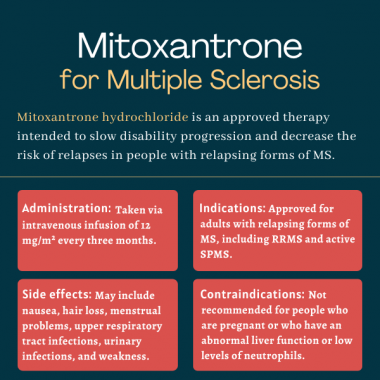FAQs about mitoxantrone
Mitoxantrone was approved by the U.S. Food and Drug Administration in October 2000 as a treatment for multiple sclerosis (MS). Indications include secondary progressive MS, with and without relapses, and relapsing-remitting MS with significant symptoms between relapses. However, the medication was first approved in 1987 for a form of blood cancer called acute nonlymphocytic leukemia and in 1996 for prostate cancer.
Based on animal data, mitoxantrone may cause harm to a developing fetus. Patients who are able to conceive should use effective contraception while on treatment and have a negative pregnancy test before each dose. Patients who become pregnant while taking this medication should discuss this issue with their healthcare team.
Interactions between mitoxantrone and alcohol have not been reported. However, alcohol can worsen some side effects associated with this treatment, including diarrhea and mouth sores. Patients on mitoxantrone should discuss safe alcohol use with their healthcare provider.
In one of the trials supporting mitoxantrone’s approval, participants received monthly treatment with either a combination of mitoxantrone plus a steroid medication called methylprednisolone or methylprednisolone alone. After six months, those on mitoxantrone had fewer brain lesions, less disability progression, and fewer relapses. However, because each person reacts to their treatment in differently, it is difficult to predict when someone will start seeing results while on this therapy.
Hair loss, also known as alopecia, is one of the most common side effects associated with mitoxantrone. Weight gain may also occur as a result of heart problems caused by the treatment. Patients who experience any unexpected side effects are advised to talk with their care team.
Related Articles

 Fact-checked by
Fact-checked by 






